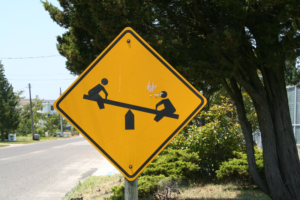Is your partner having trouble staying clean and sober from drugs or alcohol? Did you know that your relationship with an addict might be stifling their recovery?
It’s very common for family dynamics to stand in the way of their loved one’s sobriety. In fact, it’s so common, it has a name – codependency.
 First discovered by professionals who were working with addicts and alcoholics, codependency became apparent when the clients were not doing well in their recovery process.
First discovered by professionals who were working with addicts and alcoholics, codependency became apparent when the clients were not doing well in their recovery process.
A close look at the situation revealed many family members, even intimate partners, had a different type of disorder that coexisted with addiction and actually made it worse.
Once the problem was out in the open, a solution was diligently sought. Treatment programs became available to complement treatment for addiction. Professionals were then able to work with the entire family rather than the patient alone.
The condition interferes with the person’s ability to enjoy a relationship that is healthy, happy and mutually satisfying. Codependency is also coined a “relationship addiction” since individuals who have it are often in one-sided, abusive and/or emotionally destructive relationships. Santa Monica Christian Counseling offers a holistic approach to uncover and address these co-occurring disorders, providing support for individuals and families on their journey to recovery.
It was around ten years back when the disorder came to light due to the research of relationships within alcoholics’ families. The behavior is picked up from watching and then imitating the behavior of others within the family who exhibit codependent mannerisms.
The excessive need to have closeness, intensity and emotional intimacy leads codependent individuals to purposefully seek roles in which they are heroes, rescuers or caretakers, especially when this becomes a pattern of seeking out unreliable or abusive partners.
The fact that addicts and alcoholics are generally in a position to be rescued and need enablers in order to keep their addiction cycle going makes them prime candidates for codependent individuals to be attracted and becoming the root of the relationship.
Codependency, like chemical dependency, causes individuals to become trapped in a cycle where they experience gratification as well as withdrawal. They may seek passion and also experience symptoms of withdrawal such as anxiety and desperation when they sense their partner is distancing or pulling away from them.
When an addict takes off on a binge, engaging in their preferred drug, they tend to pull away. There are consequences to pay for obtaining their high or fix. That is where the codependent individual gets their chance to save the day. They swoop in and rescue the addict and therefore attain the closeness they crave and the fulfillment they long for in feeling needed.
The relationship dynamics between a codependent individual and an addict is like a dance. Codependency leads a person to enable and accept relationships that are very unhealthy and one-sided. Not only does it hurt the codependent individual but the addict as well because it only encourages their addiction.
Then again, some have an entirely different opinion on the subject. They believe that it is not good to take the matter of codependency so far as to say that it is an addiction such as drugs or alcohol are.
 In Amir Levine M.D. and Rachel Heller M.A.’s book Attached, the idea is proposed that while codependency theories are very helpful when dealing with addicts’ family members, they can also be misleading and damaging if they are applied to every relationship.
In Amir Levine M.D. and Rachel Heller M.A.’s book Attached, the idea is proposed that while codependency theories are very helpful when dealing with addicts’ family members, they can also be misleading and damaging if they are applied to every relationship.
The authors take the subject a step further to suggest that what may appear as an obsessive attachment need can also be a product of evolutionary biology. They take the approach that codependency is a construct that is influenced by an outdated concept of self-reliance and is also swayed due to social norms.
The book goes on to discuss their opinion that codependency has given healthy dependency a bad name. It reiterates the authors’ belief that dependency is a part of our very DNA and should not be disdained or labeled as negative.
The concepts in the book line up with Old Testament teaching in Genesis that speaks of a man leaving his mother and father to join to his wife and become one flesh. The authors assert that happiness has to do with our relationship with our partner rather than from ourselves or anything derived by our own means.
The book references studies that suggest that once we are attached to someone, a physiological bond is formed. The rate of our heartbeat, the status of our blood pressure, our hormone levels and even our breathing is regulated by our partner because we are a single entity.
Further reading in the book says the psychological approaches of codependency contradicts the findings from a perspective based on biological evidence. The authors conclude that dependency is not a preference or a choice but rather a fact.
The belief that two are one explains the mutual reaction partners can experience when one is unsettled, angry or downcast. The authors express that one partner can feel the emotions of the other as if those emotions were their very own in origin.
Then again, the intermingling and meshing of emotions are viewed differently by experts in the codependency field. Some perceive it as a deficiency of boundaries and believe that over-attachment is a problem, while the authors of Attached simply believe they are a result of attachment system activation.
The book also points out that a system of activated attachment does not constitute passionate, true love. If a relationship causes feelings of obsession, insecurity, and anxiousness followed by bouts of elation, it is probably because the attachment system is activated rather than it being love. Love promotes peace, not confusion and negative emotions.
Attached proposes the idea that individuals have inherent needs which must be met, regardless of how they are met, self-sufficiently or through dependence. The degree of a person’s unmet needs determines their neediness, in other words.
Attachment literature, in general, teaches that when dependent individuals effectively glean from others, they actually become more daring and independent in the process.
 There are clearly at least two ends of the spectrum. The new science teachings suggest that our dependency on others is a natural act which is predisposed through our biological makeup.
There are clearly at least two ends of the spectrum. The new science teachings suggest that our dependency on others is a natural act which is predisposed through our biological makeup.
Most codependency teachings, on the other hand, warn of the dangers of being addicted to relying on others. One thing the two agree on is that the ultimate outcome is brought about by seeking out the partner who is right for you and who meets your needs.
Addiction professionals tend to label those who are needy in nature as being addicts or codependents while those who hold to attachment beliefs, like Heller and Levine, classify them as avoidant or anxious, the dance remains the same. The two types find one another, time after time.
In an article by Terry Gaspard, LICSW, MSW, entitled “Overcoming Codependency: Reclaiming Yourself in Relationships”, the thought that people stay in relationships that are self-defeating because they feel their partner’s happiness is their responsibility or that they are afraid of being alone is explored. They may want out but stay or if they do get out, they find themselves back in the same boat in their next relationship.
The book explains that the adrenaline rush behind the feelings of passion can be addicting. It states that for a number of individuals the excessive emotional reliance is a matter of codependence in that the needs of the other person are placed before their own needs.
Attached takes the stance that biology explains the tendency as one that can be explained biologically but still acknowledges it as a difficult situation because there is the possibility that the one who is relied upon may not successfully meet the needs their partner requires.
Then, the book talks about the possibility of the person our brain assigns to be our anchor emotionally and our haven of safety not coming through and the complications that can result because of their inability or unwillingness to do so.
There are entire chapters of the book that are devoted to figuring out the difference between one’s own style and the style of an intimate partner. In addition, how styles of attachment are evident in everyday life are expounded, as well as teachings on skills that can help to effectively resolve the conflicts and improve the relationship.
Three of the styles of attachment mentioned in the book are: secure, avoidant and anxious. It is obvious that these styles are in line with three addiction model types which are: codependent, detached and interdependent.
 When a person is born within the realms of a style of anxious attachment, they long to be intimate and close to another and are afraid of losing their partner so they want to be as close as possible to them.
When a person is born within the realms of a style of anxious attachment, they long to be intimate and close to another and are afraid of losing their partner so they want to be as close as possible to them.
They pick up on subtle clues through gestures and expression and are apt to take everything personally. They tend to easily become upset which leads to acting out, saying or doing things they end up regretting.
Secure style individuals are comfortable in their own skin and tend to be warm and loving in a relationship. They value a balance of feeling secure and intimacy while effectively communicating their own needs and efficiently reading the emotional cues of the needs their partner has.
Individuals who have the avoidant style are prone to treasure autonomy and independence within a relationship. While intimacy is important to them, they don’t feel comfortable when things get too close. They don’t often open up to their partners and are sometimes accused of being detached.
Heller and Levine take the approach that their ideas are more relevant to general relationships while codependency concepts are best when reserved for relationships that deal with substance abuse and other abuse issues.
Here are some patterns that can help you determine if you may be codependent:
- Pleasing others: You have a habit of going the extra mile in order to please others or make them happy. You dislike confrontation and avoid dealing with important issues, even with your spouse, because you are afraid of rejection or are worried about how it might make your partner feel.
- Your self-worth is defined by others: Are you preoccupied with what others think about you?
- Ignoring warning signs: Do you overlook your partner’s dishonesty, jealousy or possessiveness?
- Excessive giving: It is not uncommon for you to ignore your own feelings or neglect to take care of yourself because you feel selfish in doing so.
- Your boundaries are undefined or non-existent: You often have difficulties saying “no” to others’ request and allow yourself to be taken advantage of.
- Remaining in a distant, abusive or unavailable relationship: You know you are in a relationship that doesn’t meet your needs but fail to get out of it.
There is an advantage to the Attached perspective in that it allows you to look at problems normal couples face in life without being getting bogged down in all the rhetorical lingo and the stigma that comes along with therapy directed at substance abusers and their families.
Furthermore, the book’s information can be beneficial for those who are actively looking for love because it can help direct them to ultimately find the partner best suited for them. The book also gives readers a simple way to view styles that clash and other problems so they can find solutions in order to better the relationship.
Codependency, in contrast, is more focused on toxicity within the dynamics of families when substance abuse is present. It is geared toward offering ways to break free from the individual abusive relationships and the patterns that lead to them.
All of the information offered on the subject can be overwhelming. Taking advantage of resources that are available is perhaps the most optimal way to determine if you are codependent or not. You can also find out if addiction is a factor in your family. Counselors at Santa Monica Christian Counseling can guide you through this process with understanding and support.
If you don’t find there are issues of addiction present, the book Attached has information that is very helpful for relationships in general.
“Seesaw Crossing”, Courtesy of Rachaelvorrhees, Flickr.com; CC BY 2.0 License; “Lean on me,” courtesy of Rosie Ann, peels.com, CC0 License; “Autumn Pathway,” courtesy of James Petts, Flickr Creative Commons, CC0 License; “Downcast,” courtesy of Pablo Varela, unsplash.com, CC0 License


